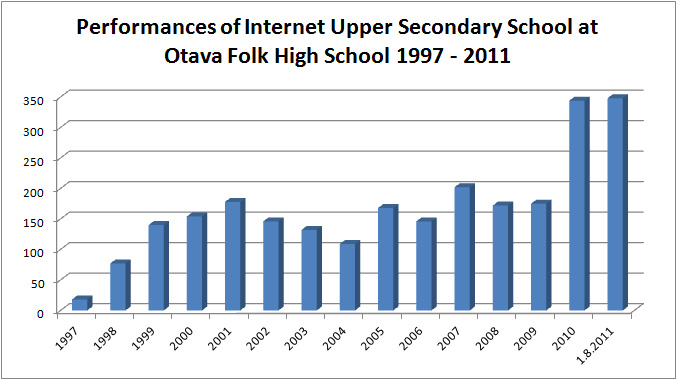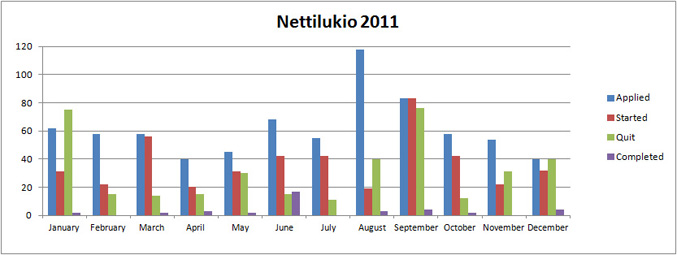Welcome to the Virtual Education Wiki ~ Open Education Wiki
Nettilukio - case study: Difference between revisions
m (→Background) |
|||
| Line 98: | Line 98: | ||
[[Image:Performances_Otava.jpg | Development of amout of students]] | [[Image:Performances_Otava.jpg | Development of amout of students]] | ||
Picture 1: Performances 1997 - 2011 | ''Picture 1: Performances 1997 - 2011'' | ||
[[Image: Nettilukio_2011.jpg]] | |||
''Picture 2: Applied, started, quit and completed in 2011'' | |||
Revision as of 07:29, 20 June 2012
General information
| Name of school | Internet Upper Secondary School at Otava Folk High School |
|---|---|
| Address | Otavan Opisto, 50670 OTAVA, Finland |
| Website | www.nettilukio.fi |
| Contact name and role | Administrator and student counsellor: Taru Kekkonen, +358 44 794 3517, taru.kekkonen(at)otavanopisto.fi |
| VISCED partner/author | TIEKE (Finnish Information Society Development Centre) / Merja Sjöblom, +358 50 567 6893, merja.sjoblom(at)tieke.fi |
| Type of school | Public |
| References |
|
Headline description of the school
Internet Upper Secondary School for adults at Otava Folk High School originates from a project called Internetix. This ESR funded project started in 1996 aiming to find solutions to take school to students instead of forcing them to travel long distances or having to move in order to get to school. In the project eLearning material was produced and special demand seemed to be in upper secondary school courses. The first distance learners of Nettilukio started in 1997 - at that point there were 13 students, today more than 500.
Nettilukio is both national and international upper secondary school for adults operating in Finnish, but students living all around the country and world. Typical virtual school student comes from one of the following groups:
- parents of small children
- professional and semi-professional athletes
- people who travel a lot (because of occupation or for other reasons)
- people living abroad
- shift workers
- people who cannot attend school for reasons of health
- people with previous negative experiences like bullying or frustration
- people living in sparsely populated areas
Flexibility seems to be the greatest advantage of distance schools. In distance school one can rhythm their schedule and studies to their other life easily. There are no terms or periods, instead each student can study according to their own schedules. There are no obligatory contact days which lead to the fact that most of students never actually visit the Otava campus.
Background
1) When was the school established? How has it evolved till now?
Otava Folk High School was established in 1892. In 1994 the school received an upper secondary school for adults status. At first the school was only a physical school, concentrating on mathematically talented students, offering coaching to math and physics.
In 1996 a project called Internetix started. Within this project the totally virtual upper secondary school for adults, Nettilukio, was founded. The first students in Nettilukio started in January 1997.
At first the emphasis was in producing eLearning material that students could use while taking the upper secondary school courses. Over the years the emphasis moved towards learning platforms and Nettilukio developed its own learning platform, muikku. The new learning platform was developed to support studies and evaluation.
Later new learning options were developed. Nowadays students at Nettilukio can choose from three different ways to accomplish courses - or they can freely combine these options between different subjects and during their studies. These three ways are non-stop-courses, collaborative courses and phenomenon based learning.
2) What was/were the reason/s for establishing a virtual/distance/online school? What specific need(s) was it aimed to address?
ESR-funded Internetix project was a starting point for Nettilukio. However, at first the project emphasis was to produce eLearning material in general for any students and any studies. Focus was to find general solutions to take school to students instead of forcing them to travel long distances or having to move in order to get to school. From a general solution the aim was moved on to vocational education and only after that upper secondary school became the main target.
At the same time the Finnish National Board of Education started to emphasize virtual schooling in adult education and especially in upper secondary schools for adults. This offered support for Internetix project as well and encouraged the idea of founding a virtual upper secondary school for adults.
From the beginning one aim was also to be able to work over borders of different school levels. Transparency and trust were the guiding ideas from the beginning.
Trust and transparency have also been performed when deciding not to create official and exact follow-up systems. Nettilukio trusts its students and one of the basic assumptions is that students understand that they are studying for themselves and for life - not for the school and examinations.
2 a)Who were the main intended beneficiaries? And the profile now?
First aim was to find solutions to take school to students instead of forcing them to travel long distances or having to move in order to get to school.
Today Nettilukio students live all around the country and world. Typical virtual school student comes from one of the following groups:
- parents of small children
- professional and semi-professional athletes
- people who travel a lot (because of occupation or for other reasons)
- people living abroad
- shift workers
- people who cannot attend school for reasons of health
- people with previous negative experiences like bullying or frustration
- people living in sparsely populated areas
At the moment people with learning disabilities, previously bullied or otherwise frustrated in physical schools seem to be the major target group. Distant school offers great opportunities for those who do not like face-to-face contacts but may be very active in social networks. Distant school without strict schedules is also a great opportunity for those with learning disabilities, because they can study in their own base and take their time to learn chosen subjects.
2b) has the aim changed over time?
Trust and transparency are the guiding methods still. Otherwise the school is guided by national curricula, laws and regulations.
3) Current number of students?
There are two types of students at Nettilukio: those who take individual courses and those who aim to graduate (with or without matriculation examination).
The amount of students taking individual courses has grown and even doubled over the past years. There are several reasons to this: if the course is not available at his/hers own school, one can easily study it virtually. Also, if a student is not currently studying in any other secondary school (upper or vocational), studying is free of charge - this motivates individuals to update their knowledge by taking virtual courses. In these cases Nettilukio receives a state grant (15 single courses are considered as one student).
The following two charts show development of performances at Nettilukio from 1997 on and also number of different student types during the year 2011.

